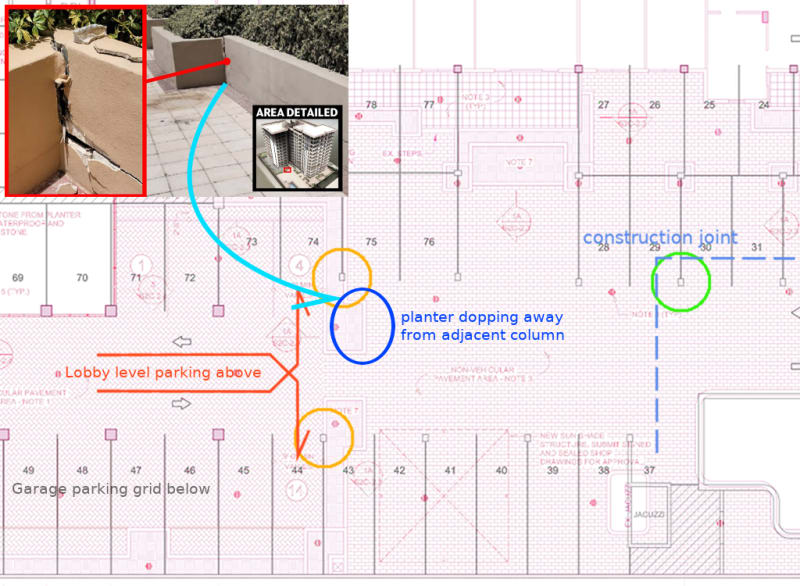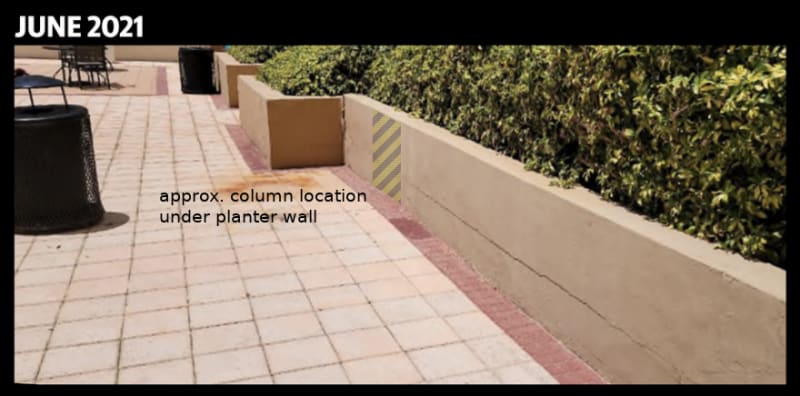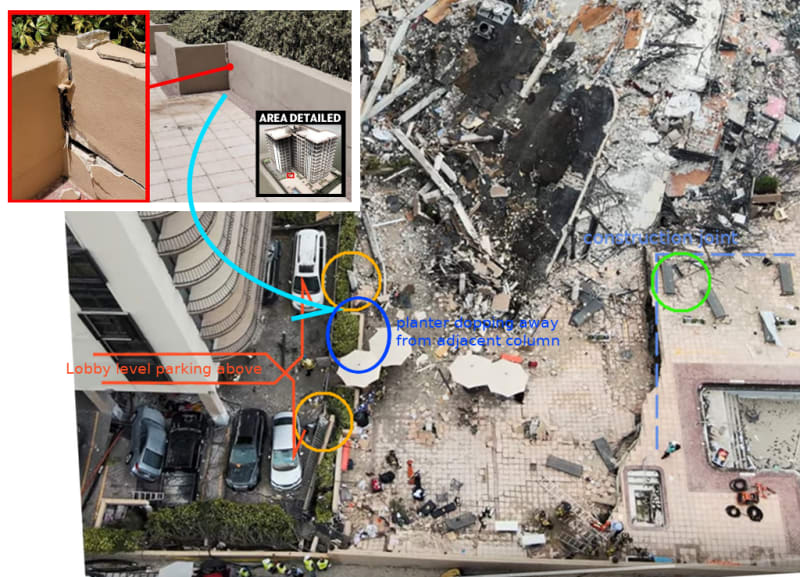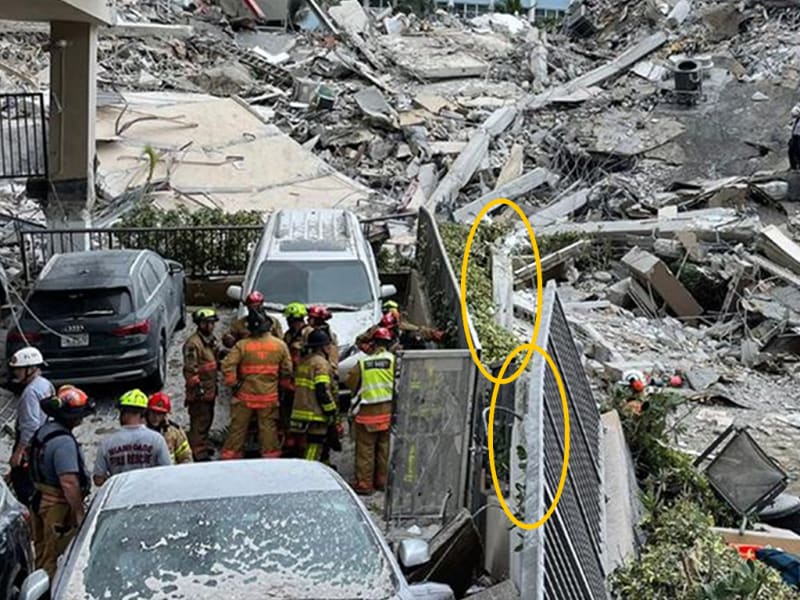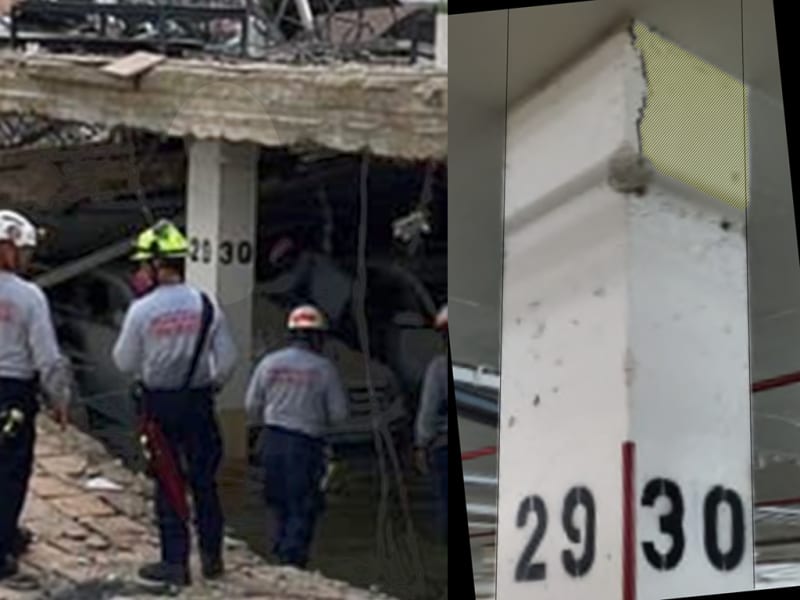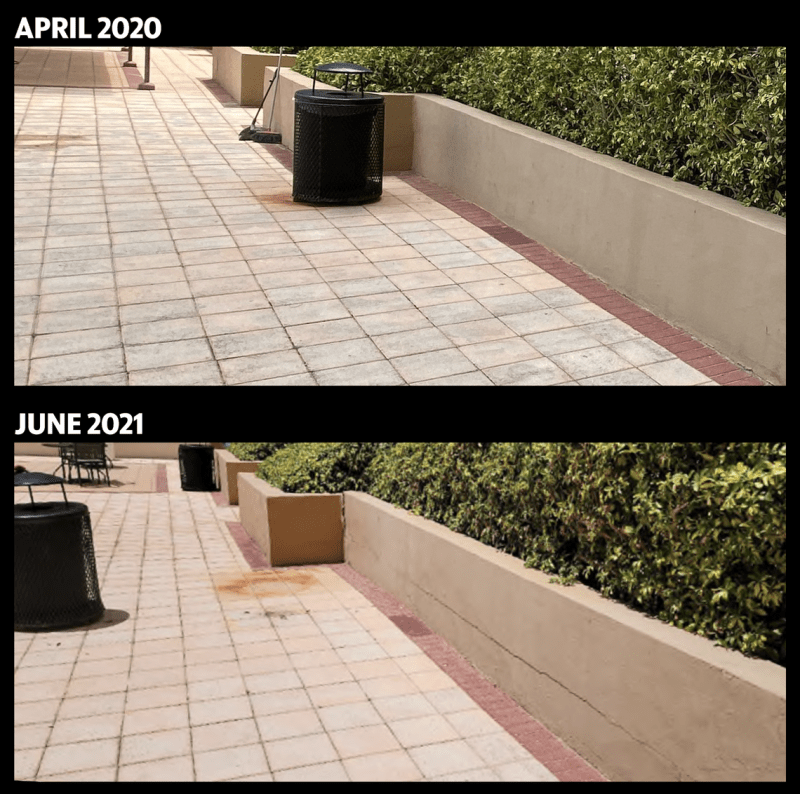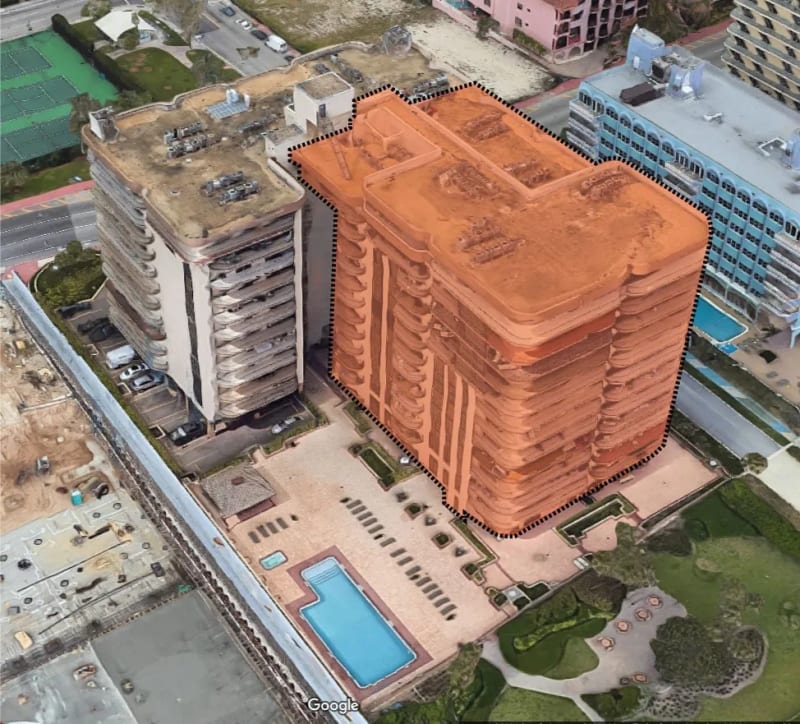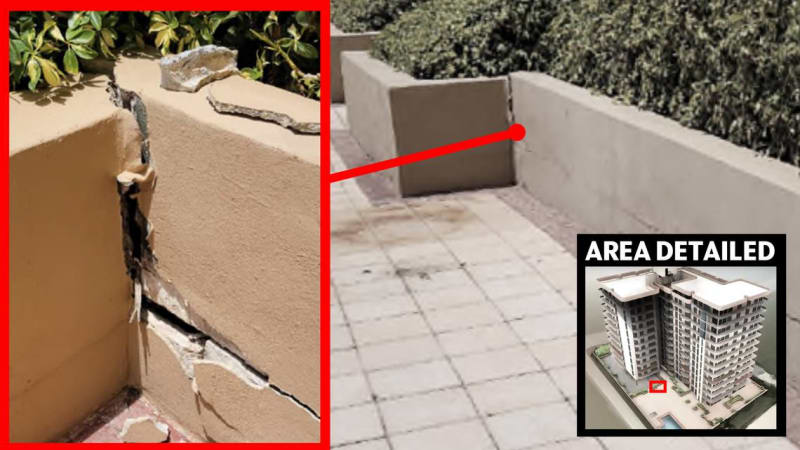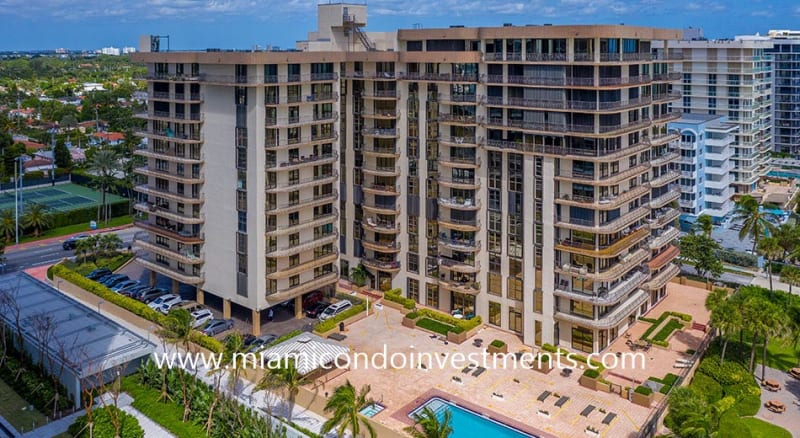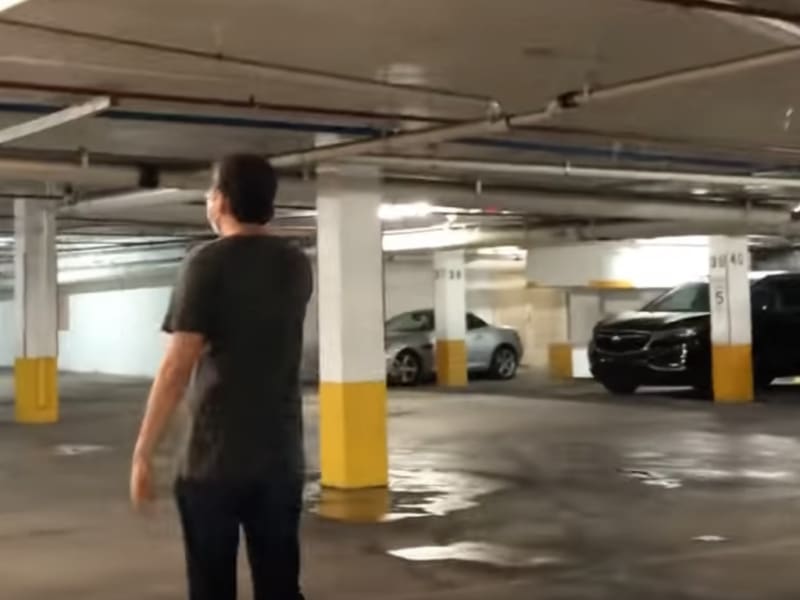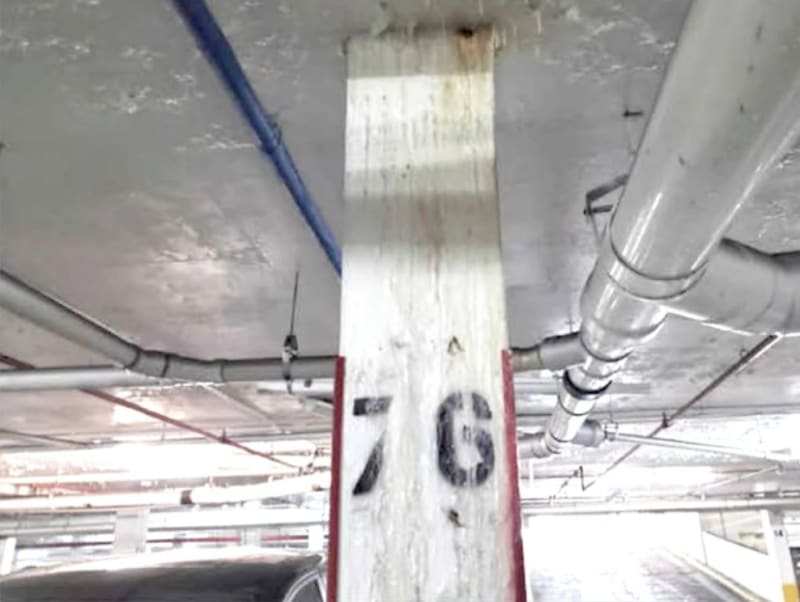Josh Porter is featured in this Miami Herald subscriber-only bombshell article,
Surfside condo was ‘screaming’ as an alarming crack formed just weeks before the collapse. There are photos taken about a month before the collapse showing severe cracking in the planter by the parking deck. The archive I made in this link only shows a teaser rather than the entire article. Perhaps a subscriber can copy it out for us.
>>>>>Edit: A subscriber in a FB group I monitor copied out the text.
SURFSIDE CONDO WAS ‘SCREAMING’ AS AN ALARMING CRACK FORMED JUST WEEKS BEFORE THE COLLAPSE
By Sarag Blaskey, Ben Conarck, Nicholas Nehamas
Updated May 14, 2022
Less than a month before Champlain Towers South collapsed last June, the building manager noticed something that made him pause on one of his near-daily walks around the property: A large horizontal crack, maybe 20 feet long, had formed in the planter along the western edge of the pool deck.
So he called a structural engineer working for the building to come check it out.
The long crack hooked upward on one end in a gaping vertical fracture as if the planter was being torn apart at one corner, photos taken during the June 8, 2021, inspection and included in court records showed. The concrete-block wall on one side of the vertical crack appeared to be about an inch lower than the other, as if part of the planter had started to slump into the garage below.
The planter itself did not play a role in the building’s structural integrity. But the dramatic change in the height of the wall on one side of the vertical crack suggested the structural slab below could have been starting to fail a possible canary in a coal mine warning of the deadly collapse that would happen on June 24, six structural engineers who reviewed the photos told the Miami Herald.
A cracked planter alone isn’t enough to cause major alarm, the experts said, but the slab nearby had been showing signs of distress for months. Photos exclusively obtained by the Herald show water had poured through the slab, cascading down a column supporting the pool deck just 20 feet from the planter. The file names suggest the photos were taken in November 2020. Josh Porter, the president of Punta Gorda-based Consult Engineering, said the photos from November were already “evidence of imminent collapse.”
“This building was definitely screaming that it was in dire straits,” said Porter, a structural engineer who specializes in restoration of high-rise condo buildings.
His concern was more than water damage to the column.
The amount of water streaming down it was a sign that the slab was already severely cracked around the top of the column, Porter said. It looked to him like the slab might soon break away from the column supporting it. “Most engineers would say this is a serious problem: Part of your pool deck could collapse,” Porter said.
The crack in the planter months later suggested the problems in the pool deck slab had likely worsened, although more inspection was necessary to be certain the two problems were linked, the engineers consulted by the Herald said. Although it’s unclear exactly when the problem in the planter started, a photo dated April 20, 2020, shows no vertical displacement between the two planter walls and no cracking at all. “That’s a lot of movement in one year,” said Florida engineer Nestor A. Cueto of Miami-based Cueto Engineering. “If it was noted that significant movement of that area occurred after the previous inspection, that would be a cause for additional investigation.” Cueto, who performs 40-year inspections, said that given the other problems in the basement, he would have also requested temporary emergency shoring while simultaneously investigating the underlying cause of the crack. The town of Surfside requires a permit to place temporary shoring, which generally involves positioning adjustable, steel support jacks to relieve some of the pressure on weakened structural elements.
A spokesperson for the town’s building department confirmed no permits for shoring were taken out for Champlain South in the month before the collapse.
On June 24, just two weeks after the cracked planter was discovered, the slab broke away from the columns a type of failure known as flexure-induced punching shear that the engineers told the Herald was both predictable and likely preventable based on what they observed in the photographs. The planters and pool deck crashed down into the underground garage below, kicking off a chain reaction that resulted in the collapse of most of the 12-story residential tower. Ninety-eight people died.
MISSED SIGNALS
Scott Stewart, the building manager of Champlain South since 2019, kept a close eye on the structure that was approaching its 40th birthday. “We did a property walk almost every day for safety of the property,” Stewart told the Herald in an exclusive interview. Whenever he saw anything out of the ordinary, Stewart said he immediately called Frank Morabito, the engineer first contracted by the condo association in 2018 to inspect the building in preparation for the required 40-year recertification of the structure. Records show Morabito and his team inspected Champlain South frequently between 2018 and 2021, taking photographs and writing nearly half a dozen reports noting the pool deck slab was in urgent need of repair.
Despite the building’s history, when Stewart called about the cracked planter he noticed early last June, the manager said Morabito wasn’t worried and told him the problem could wait a few days until the next scheduled visit. “Discussing it with the engineer, it wasn’t determined to be an emergency situation,” Stewart said. “So when the junior engineer came out to do the inspection of the roof, he [Morabito] had him look at it then.” The inspection of the planter on June 8 didn’t last more than 15 minutes, Stewart said. He said Morabito determined from photos sent by the engineer on site that the problem was cosmetic and caused by roots penetrating the cracks of the decades-old planter.
“It was determined there was no immediate action needed,” said Stewart, who appears in one of Morabito’s photos from the day. The planter would be removed as part of the overall renovation plan just getting underway at the tower, he said.
Stewart said he remembered seeing some roots in the crack, but engineers consulted by the Herald say that wasn’t enough to determine the cause of the break definitively. “Part of these visits was to monitor the building, so if you see a significant change in something, that should be a red flag,” said Dawn Lehman, professor of engineering at the University of Washington and a consultant on the Herald’s collapse investigation. While it is possible that roots damaged the planter, it is not the only explanation for the gaping crack, nor even the most likely given the timeline and condition of the slab below, Lehman said. “If you come in time and time again and you see a change, you don’t make an assumption, you do your job,” Lehman said. “The building was talking to Morabito and he wasn’t listening.” Given previously documented evidence of damage to the slab in the area and how rapidly the cracking formed in the planter, engineer Shankar Nair said Morabito’s team should have considered potential structural causes.
“I believe this was a very serious warning sign,” Nair said. “If the structural engineer saw what I see in this picture [of the water coming through the slab] and then saw the crack in the planter … he should have put it together.” At the very least, Nair said engineers should have checked the slab for evidence of structural problems. Problems with the slab would have been obscured from view from above by planters and decorative pavers on the pool deck. So, experts said, Morabito’s team should have gone to the basement-level garage to look up at the slab from below, where cracks, sagging or other more definitive evidence of structural problems would have been more obvious. “If he didn’t, that would be on the edge of being irresponsible, to not run downstairs right away,” Nair said. “He absolutely should have done that.”
But Stewart told the Herald he didn’t remember anyone from Morabito’s team going to check the slab from below after they photographed the cracked planter on June 8. He would know, he said, because he would have been the one to bring them down there. Nor was there any immediate plan to tear up the pavers and planters to look at the slab below them something that would not begin until phase II of Morabito’s restoration plan, documents show.
The photos of the cracks in the planter wall were included in exhibits filed as part of a massive class-action lawsuit seeking compensation for unit owners, survivors and relatives of those who died in the tragic collapse. “Proper and immediate shoring under Morabito’s direction may have prevented the collapse of the entire building,” according to the filing by Stantec, the architects of Eighty Seven Park a luxury condo tower next door to Champlain South that victims partially blamed for the collapse. All the firms associated with Eighty Seven Park denied that their construction project had anything to do with the collapse, which happened years after construction ended.
“Certainly, Morabito should have immediately evaluated the condition and stated its structural engineer[ing] conclusion as to whether the partially collapsed planter required immediate and emergency shoring,” the filing continued. On Wednesday, Champlain South’s court-appointed receiver announced that the plaintiffs and defendants, including Stantec and Morabito, had reached a global settlement of nearly $1 billion. None of the defendants admitted wrongdoing. Morabito will pay $16 million through its insurance firm. The plaintiffs had accused the firm of failing to warn residents that the building’s structural problems necessitated immediate repairs. and possibly even evacuation.
A spokesperson for Morabito Consultants did not respond to the Herald’s specific questions about what actions were taken after the crack in the planter formed and whether there was any investigation of the area below the planters, but defended the firm’s work and reputation. “Morabito Consultants are structural engineering experts with a well-earned reputation in the industry,” Brett Marcy, the spokesperson, said in a statement to the Herald. “We share the desire to better understand what may have caused this tragedy, and we are hopeful that the global settlement announced today between the many parties involved will bring some closure to all those impacted by it.”
Records show Morabito warned the condo association about structural problems at the building. But in a court filing the association said he never determined whether the building was “safe, safe with qualifications, or unsafe,” as required in his contract. The federal National Institute of Standards and Technology continues to investigate the cause of the collapse, although its report may not be released for years.
AN EXPERIENCED ENGINEER
In the spring of 2020, the Champlain South condo association met under mounting pressure to do something about the laundry list of deferred repairs that were becoming impossible to put off any longer ahead of the building’s 40-year recertification. The association was chiefly considering hiring Morabito, a reputable engineer from Maryland with decades of experience who was establishing a foothold in South Florida in the latter stages of his career. Morabito describes himself on his website biography as a dual citizen of Italy and an active philanthropist of Italian charities.
“Some might be surprised by his skill on the billiard table, though he’s more likely to be found playing golf or reading golf books while enjoying a glass of red wine,” the biography reads. Morabito spent the bulk of his career expanding his business in Maryland with his two brothers Fred and Anthony all of them having University of Maryland degrees. In 2018, Morabito pivoted to South Florida as his primary business hub. His state license is active, and he first registered his company with Florida regulators in 1990. Huddling in May 2020, the Champlain South condo board noted that a prior board had already hired Morabito to perform an inspection on the troubled tower, which went well enough to earn him a recommendation from the association’s 40-year committee. The board ran several reference checks on Morabito, citing various South Florida projects he had worked on. The feedback was overwhelmingly positive, though he had been described by one person as expensive.
It wasn’t noted in the board’s presentation, but Morabito did battle one high-profile lawsuit in his career. In the late 1990s, the College of Notre Dame of Maryland sued Morabito Consultants for negligence and breach of contract over a 1991 renovation of Gibbons Hall, an administrative building on campus. The project included converting residential space on the fifth floor into classrooms and offices, and Morabito Consultants was hired to perform the structural engineering. Several years later, in 1997, a separate engineering outfit performed a routine inspection and described “significant movement ‘internal to the building’ on the fifth floor,” according to the lawsuit. The firm concluded that Morabito Consultants failed to properly calculate the increased load brought about by the change in building usage, causing the building’s trusses to become overstressed. A Maryland circuit court and appellate court both dismissed the suit, saying it was filed after the statute of limitations had expired. Abieyuwa Aghayere, a Drexel University engineering researcher, said that type of mistake was not a run-of-the-mill mix-up, based on his review of an appellate ruling. “You typically would design for the new load and check it, and maybe reinforce the [trusses] if need be,” he said. “The fact that [Morabito Consultants] didn’t do that here is concerning.”
Aside from that lawsuit, Morabito Consultants earned favorable marks from the condo buildings that Champlain South checked with. On his website, Morabito cites his favorite renovation project as the Dolphin Towers condo renovation in Sarasota, which had been evacuated in 2010 after a giant structural slab between the third and fourth level failed. Morabito Consultants was called in to help fix the condo tower. Jim Toale, the president of the condominium association, said Morabito was hired by the contractor who handled the Dolphin Towers renovation, and came up with a solution for the issue with the slab. While he was there, Toale added, Morabito flagged warning signs of punching shear in the parking garage, prompting future repairs. “We’ve had no issues with Morabito,” Toale told the Herald. “What they fixed, it’s still solid.”
A BUILDING ‘CRYING OUT’
In November 2020, Stewart, the building manager, was touring the underground garage with someone from Morabito’s engineering firm. It had just rained, Stewart said. And, as usual, puddles covered the floor, proof of the failed waterproofing on the pool deck, which Morabito had noted was causing “major structural damage” to the slab. In one report, Morabito said urgent repairs were needed to prevent the problems from becoming exponentially worse. That day, the engineers focused on an area around one column in particular a 12-by-16-inch pillar of concrete painted with the number 76, demarcating a parking space in the middle of the garage. Photos taken that day showed water streaming down the column, causing the paint to run and sediment to build up at its base. “We were trying to figure out basically where the moisture was coming from,” Stewart said.
Other columns around the garage were sometimes wet, mostly from leaking pipes, the manager said. But column 76 was by far the worst. One engineer who looked at the photo for the Herald called it a “waterfall.” Stewart said Morabito’s team snapped the pictures of the column and slab above it to include in a bid for the upcoming concrete restoration process set to begin the following year. But if they had more immediate concerns about the structural integrity of the area, they never told Stewart.
They took the pictures and then did “nothing” more, Stewart said. Morabito made no mention of the column in any reports to the board reviewed by the Herald. “It’s shocking,” said Aghayere, the Drexel professor. “This column was almost crying out; it was the structure crying out saying ‘fix me, do something about me,’ ” he said. Knowing that the structure was poorly designed, with almost no redundancy, Aghayere said the problems documented in the photographs that day “would have scared the daylights out of me.” “I would have shored it up with a goal to evacuate the building, knowing what I know about the structure and how it was designed,” he said.
The western half of the pool deck, which caved-in on June 24, was held up by narrow columns placed up to 30 feet apart to maximize parking space in the garage below. It was a flawed design that left the 9.5-inch concrete slab cracking and bending under its own weight from day one, computer modeling by Lehman, the University of Washington researcher, showed. The building designs had originally included beams to support the planters from below, but they were removed in the final drawings, leaving the slab and columns alone to support the boxes of heavy wet earth.
Over the years, pavers and sand were layered on top of the original tiles, permits show, adding more weight to the overburdened deck. Roots from the planters penetrated the slab and cracked drain pipes causing water damage to the concrete and reinforcing steel bars within it, records show. Post-collapse photos show the connections between the slab and columns did not contain all of the reinforcing steel that was called for in the plans, reducing the strength of those critical connections. Photos also show damage and corroded rebar along the deck’s connection to the southern perimeter wall, which experts said played a role in the overall structural stability of the tower. In a well-designed structure, experts said the localized failure of a pool deck should not cause the collapse of a whole tower. But at Champlain South, the design defects, construction errors, damage, degradation and poor maintenance came together in a perfect storm leading to one of the deadliest collapses in modern history. It began when the deck collapsed at 1:15 a.m. Columns punched through the slab, which disconnected from the southern foundational wall. After losing that critical connection, computer models showed damage propagating into the tower.
But missing from the public understanding so far has been what initiated the collapse. The collapse could have been triggered by column 76 suddenly punching all the way through the slab, as it had apparently been threatening for months, engineers said. Or, they said, some failure of the connection between the deck slab and structural perimeter wall or elsewhere could have triggered the punching shear at column 76 and across the western pool deck. “Are we ever going to know what the very first thing was? I doubt it,” said Porter, the Florida engineer, who has studied the collapse extensively and posts his findings on a popular YouTube channel. “Whether [column] 76 happened before the south wall failed, or vice versa, you’re going to end up with the same result.” Regardless, if the connections between the vertical and horizontal elements of the structure had been stronger and the columns had never punched through the pool deck slab, it’s possible the deadly collapse of the tower would have never happened at all, engineers agreed. “This could have been prevented,” Aghayere said.
Porter cautioned against assuming the warning signs were as clear without the benefit of hindsight. No one would have expected the building to fall down solely because of a partial pool deck collapse, he said. “When you do this for 30, 40 years and see horrendous buildings and bridges and none of them collapse, you end up with this false paradigm that buildings can’t collapse,” Porter said. “You’re so stuck in that paradigm that you can’t fathom that something catastrophic is about to occur,” he said.
#FeaturedArticle #investigation #CTS

